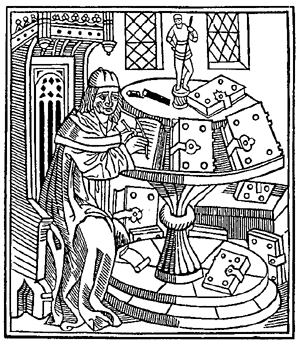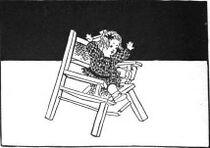Chair

“If your knees bent the other way ...”
– Steven Wright on what a chair would look like
A chair is a completely very much useful household apparatus, introduced into American homes by Ivan the Terrible in the late 16th century, and was originally intended to be used as an alternative to isopropyl alcohol until people realized that they could be used for sitting.
History[edit | edit source]
The earliest chairs were used by cavemen and took the form of rocks. Cavewomen generally approved of these at the time because the rocks were usually hard with uncomfortable points on them, and this kept the cavemen from spending too much time just sitting around on their lazy patoots. As the cavemen hunted, over time, they were able to find more comfortable rocks, which they brought home and used to replace the less-comfortable rocks favored by the women. As the cavemen found more comfortable rocks, they spent more time sitting and playing in the fires, rather than doing more productive activities. Soon the women began to hide and discard the comfortable rocks and replace them with pointier models. Womens' chair-removal organizations grew and for many centuries the men were powerless to keep their comfortable chairs. Over time this gave rise to the notion that the women should be the interior decorators. The average chair is wooden or plastic with a flat bottom and horizontal back.
However, after several grueling centuries, mens' sore butts motivated them to organize enough to get more comfortable chairs, and in Ancient Greece, men managed to pull a fast one on their wives and procure comfortable chairs. Because television had not yet been invented, the men created parliament and used it as an excuse to waste more time sitting in their chairs. Eventually even men in the lowest caste of the Ancient Grecian society had comfortable chairs, and soon absolutely no work was being done. Men from other nations heard about comfortable chairs, and decided to take them by force instead of making them themselves. The armies of Ancient Greece, lax from too much sitting around, were quickly overpowered, which led to the fall of that nation.
Over time the cycle of hard chairs changing to comfortable chairs led to the fall of several notable empires and monarchies, including the Roman Empire, the Ottoman Empire, and even kingdoms in Biblical times. When David spent his time herding sheep, he was easily able to defeat Goliath (see 1 Samuel 17). However after he began to sit on a throne, he soon fell prey to usurpers (see 2 Samuel 15). Only after he roamed around in the wilderness without a chair for awhile was he able to reclaim his kingdom (see 2 Samuel 18). In yet another example, in pre-modern Japan the samurai, who knelt on the floor in a very uncomfortable position, were able to quickly take power from rulers in chair-sitting fiefdoms.
After the invention of the printing press by Johannes Gutenberg in 1448, people (mostly the women) began to read the Bible and other historical documents and re-learned the folly of chairs. Puritan Christians who learned from all of David's mistakes outlined in the Bible, soon invented chairs that would keep their men from being lazy and overrun. However, over time as chairs again began to increase in comfort, men had to invent work that required them to spend more and more time sitting in chairs to keep the women from again replacing their comfortable chairs with pointy rocks. Thus professions such as the computer programmer and the technical writer were born.
Chairs in the arts[edit | edit source]
Throughout history chairs have been thought of as a symbol of artistic design and beauty, a ruse that has been perpetrated from prehistoric times.
Prehistoric chair art[edit | edit source]
In an attempt to bring chairs into their caves, some more enterprising cavemen tried to convince their women that a chair could be a thing of beauty, and proceeded to paint pictures on them. This was a dismal failure because the women couldn't stand the "oggie ikkie ug bahd" (translation "uglier than Ug's pimples") paintings. Not understanding the entire Men are from Mars, Women are from Venus concept, cavemen were baffled as their most comfortable rocks on which they had painted pictures of "goohi nummi fuhnn" (translation: "exploding mammoth intestines") were removed by the women at mind-boggling rates. Current cave paintings resulted from the caveman's attempts to practice before putting the real picture on the chair.
Ancient and Classical period chair art[edit | edit source]
No attempt at chair art was successful prior to the ruse the Ancient Greeks pulled on their wives. Sick of hunting and gathering, the Greeks of that period began to cultivate land so they wouldn't have to walk so far. This left them with an excess of time while they stood around and waited for their crops to grow. Bored farmers got together to gamble in the local assembly halls, where they played games involving leaves, twigs, and cow patties. Because the rules for these games were often open to interpretation, several unlucky farmers spent painful nights explaining to their wives how a single kick from the horse could leave a bruise in so many different locations. Soon enough the farmers had to pound out the rules, which lead to heated debate, and eventually, parliament.
Initially, those elected to parliament parked their cans on tree stumps, but after constantly having to pull slivers out of their husbands' tender tooshies, the wives relented and allowed chairs. The chairs were great, and the men wanted them in their homes, so they brought in some slave women as consultants and forced these women to work until they had constructed a chair that would be aesthetically pleasing to all women. This chair was copied many times over until several of these were in each home. Greece was ripe for invasion.
With the rise of Rome, Cleopatra VII realized that all her armies had become fat lazy slobs and ordered all of the aesthetic chairs burned. However, it was too little too late and the armies of Rome invaded and learned about chairs. Cleopatra did succeed in destroying all of the aesthetic chairs and the plans, designs, and drawings of them before she committed suicide as the Romans invaded. Sadly, no one knows what those chairs looked like.
Medieval & Gothic period chair art[edit | edit source]
After the fall of Rome, competing nations began to use chairs as a tool to undermine their rivals. They would make and send chairs as "gifts", with the intent of making opposing armies as fat and lazy as possible. This included thrones and chairs for generals, admirals, and noblemen. This was passed off as art as much as possible. Some, such as Aristotle's, were designed to keep him from ever getting up. (Note the overhanging points.) Aristotle, however, being one of the sharper knives in the drawer, wore his helmet to thwart this cunning chair-espionage tactic.
Renaissance chair art[edit | edit source]
During the renaissance chairs became commonplace in nearly every home, and people just got fat, lazy, and horny. Chairs could not be used to military advantage anymore, because everyone had them. If the art is to be believed, women no longer cared about chairs and laziness, because they all ran around completely naked. Art on chairs (and in general) became nothing but a pervert fest and the men parked their butts in chairs as much as possible just to sit and stare at the nude figures designed on them. Images such as the one in the famous painting Venus Dormida (No, I'm NOT going to post it! You'll just have to get your perverted jollies somewhere else!!!) are common of the chair art of the day. It turns out that a previous incarnation of Hugh Hefner was a main adviser to the influential artists of the day, although he had no artistic talent whatsoever.
Baroque chair art[edit | edit source]
During the Baroque period, chairs had no art whatsoever. People had been sitting in chairs so long that no one gave a rat's dead carcass about putting quality into them. In fact, when you sat in one it simply baroque. This became quite a problem when chamber pots were placed in chairs, e.g. Goldilocks and the Three Bears.
Neo-classical chair art[edit | edit source]
No one cares about these Classical period wannabes!
Modern chair art[edit | edit source]
Today chairs come in the most ridiculous styles and patterns imaginable, all of which are called "art". Mostly they have been designed by enlightened women (or men who are just plain whipped) who have again realized the true consequences of chairs: making people butt-lazy. The real purpose of these chairs is to make wasting time much less enjoyable.
Fun with chairs[edit | edit source]
In recent times, and even not-so-recent times, chairs have been a source of entertainment for children of all ages. For centuries children have had a great time playing train and airplane using chairs. In fact, Sir Isaac Newton is said to have enjoyed playing "nighttime raid over Berlin" with his teddy bear as co-pilot. This is how he really come up with the theory of gravity, not that silly apple thing.
- Musical
injurieschairs Chairs are arranged in a circle facing outward with one less chair than players in the game. Everyone walks around the chairs while music plays. When the music stops everyone fights viciously to get a chair. The player who does not get a chair must leave the game and one chair is also removed. Generally this person leaves on a stretcher. Play resumes as before. The last one not bleeding wins. - Change chairs Chairs are arranged in a circle facing inward. Everyone but one person is sitting in a chair. The one person not on a chair stands in the middle. This person calls out a group such as "people with blue eyes", "people who are keeping a dirty little secret from their spouse" or "girls who I really hope will end up sitting on my lap". Everyone who is a member of that group has to change chairs. The person who called the group tries to take one of the recently vacated chairs.
- Chairs the game There is a game called chairs where the players stack small plastic chairs. I couldn't figure out the rules, but it looks really fun. Sort of.
- You took my chair Place a chair for everyone in a circle with all chairs touching. One person stands up and is "it". That person tries to sit down in the open chair, and the group strategically moves to ensure that someone is sitting in the open chair before the "it" gets there. If "it" makes it into the open chair, the group decides who was trying to beat that person to the chair, and that person becomes the new "it". This game can be even more fun if some of the legs on the chairs have been partially cut before the game starts.
Chairs and crime[edit | edit source]
Inventive criminals over the ages have been really stupid and used chairs for all sorts of nefarious schemes. While everyone knows chairs are for being lazy, not committing crimes, several evil-doers have come up with some ways to make chairs criminal. (Seriously, I didn't make any of this up.)
- After Tyjuan Custis and Alphonso Marvin Wilkins Jr. of Millville, New Jersey, got into a heated argument, Custis picked up a machete and Wilkins picked up a chair ... and the argument escalated. For his role in the violence, Wilkins was charged with "possession of a chair for an unlawful purpose". If you live in New Jersey, you seriously have to look up the statute on this to see if your New Jersey Senator or Congressman voted to make "possession of a chair for an unlawful purpose" a crime.
- In Boca Raton, Florida, after a man's patio chair disappeared and he found it at his neighbor's rental property, the man called police to report "unlawful borrowing". Most people just call it stealing.
- Texas Rangers reliever Frank Francisco was arrested after he chucked a chair into the stands, injuring two people and giving one woman a broken nose. Jennifer Bueno, who was on the receiving end of the chair-turned-projectile has publicly stated that she will not be sending Francisco a Christmas card this year.
Chairs and religion[edit | edit source]
Citing the inherent evil in chairs, several religious groups have shunned them and urged others to follow suit. Leading the charge is the Eastern Orthodox Hippie movement commonly found among the Kookie ethnic group of Eastern India.
According to a spokesman for the group, "Please to be understanding that we are always to have been peaceful. But those very bad who are miscreants people out of from New Delhi have are always to be wanting to corrupt our very most precious youth ones with by using the weapon of laziness of the evil and very much bad chair. We cannot to be having this evil chair badness very much being allowed in our is beautiful land space."
The Kookies have been fighting for Independence from India claiming that they declared Independence from the British Empire the day before Ghandi did, and the boycott of chairs is simply another tool in their fearsome arsenal of weapons launched daily at New Delhi.
See also[edit | edit source]
“Hello, are we recording yet? Oh we’re already on? Ahem ... A careful study of the effects of chairs has determined that they reduce exercise and promote bodyitis (a swelling of the entire body). Avoid them whenever possible. (Unless you don’t want to, because no one ever listens to me anyway. I mean has the smoking warning done any good? Seriously people, if you don’t start listening to me, YOU’RE ALL GONNA DIE!)”
– the Surgeon General





